Friday, December 11, 2020
Ears were made for sounds like these
In 1970 GenRad published a lively little handbook of sound measurements.
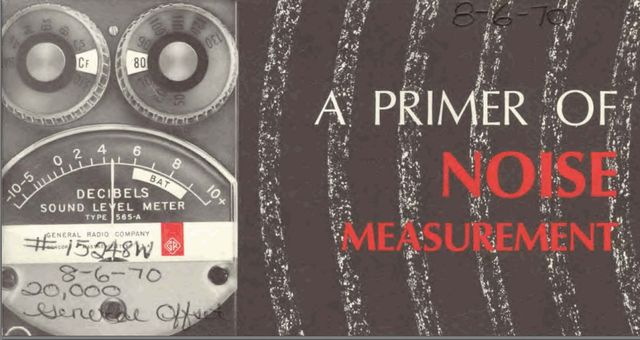 IETlabs continues to make and calibrate derivatives of GenRad products, and performs a tremendous service by maintaining old GenRad publications online. Maintaining old records of old technology is an even more important form of calibration in an era of Github memoryholing. Clearly they were using the original booklet from GenRad files, not one of the 20,000 printed copies that were ordered by the original form. Calibration at all levels! Thanks, IETlabs.
The book was aimed at industrial tech types who were suddenly required to deal with noise measurements by new OSHA regs in 1970. GenRad's simple sound level meter at that time (the 1565A) looked like this:
IETlabs continues to make and calibrate derivatives of GenRad products, and performs a tremendous service by maintaining old GenRad publications online. Maintaining old records of old technology is an even more important form of calibration in an era of Github memoryholing. Clearly they were using the original booklet from GenRad files, not one of the 20,000 printed copies that were ordered by the original form. Calibration at all levels! Thanks, IETlabs.
The book was aimed at industrial tech types who were suddenly required to deal with noise measurements by new OSHA regs in 1970. GenRad's simple sound level meter at that time (the 1565A) looked like this:
 The artist took full advantage of the meter's face, turning it into a character.
The artist took full advantage of the meter's face, turning it into a character.
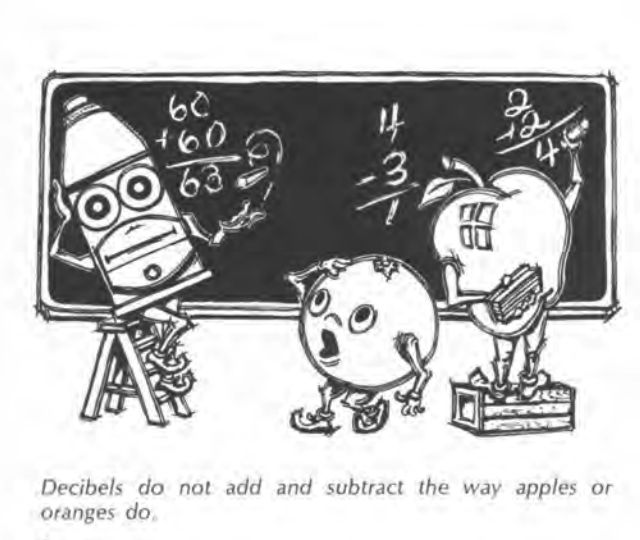 Decibels don't add like apples and oranges.
Decibels don't add like apples and oranges.
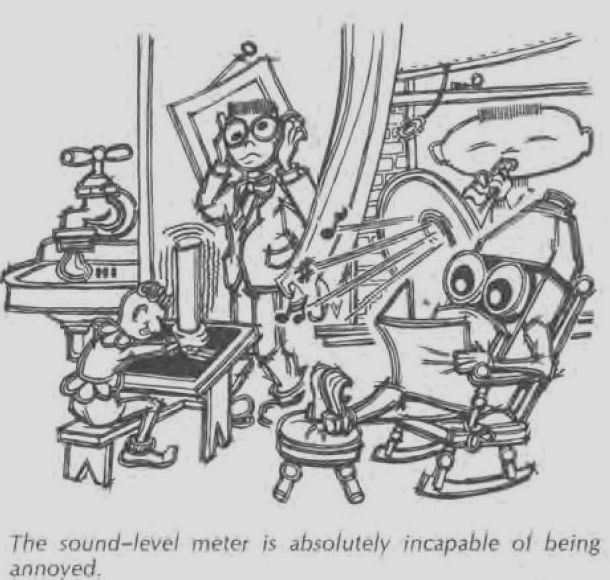 Meters and humans don't work the same way. Human hearing is totally oriented toward filtering OUT stuff that doesn't matter, and bringing IN new information in the strict sense. If a sound is meaningful and new, we focus on it, starting with the remarkable tip-link mechanism in the cochlea, and continuing all the way into the higher language centers.
The meter has no idea which sounds are meaningful. It just picks up waves of air pressure and filters them by frequency.
Here's how the GenRad book balances out the human and meter perceptions:
Meters and humans don't work the same way. Human hearing is totally oriented toward filtering OUT stuff that doesn't matter, and bringing IN new information in the strict sense. If a sound is meaningful and new, we focus on it, starting with the remarkable tip-link mechanism in the cochlea, and continuing all the way into the higher language centers.
The meter has no idea which sounds are meaningful. It just picks up waves of air pressure and filters them by frequency.
Here's how the GenRad book balances out the human and meter perceptions:
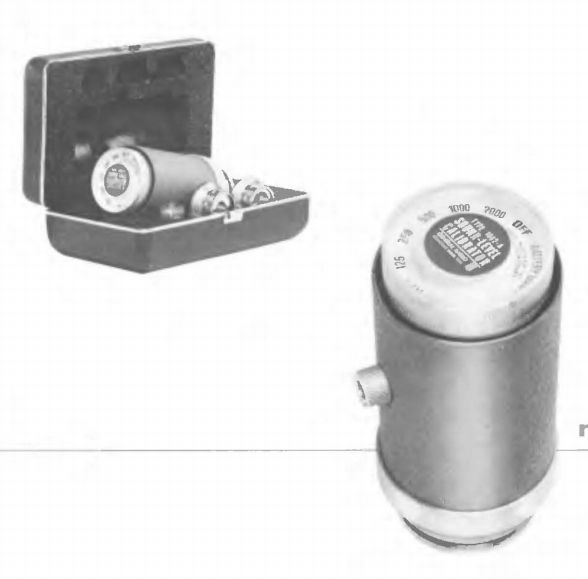 For absolute calibration, acoustics uses a pistonphone. The pistonphone is both absolute and definitional. It produces waves of air pressure with a permanent and unalterable amplitude, at a mostly consistent frequency.
For absolute calibration, acoustics uses a pistonphone. The pistonphone is both absolute and definitional. It produces waves of air pressure with a permanent and unalterable amplitude, at a mostly consistent frequency.
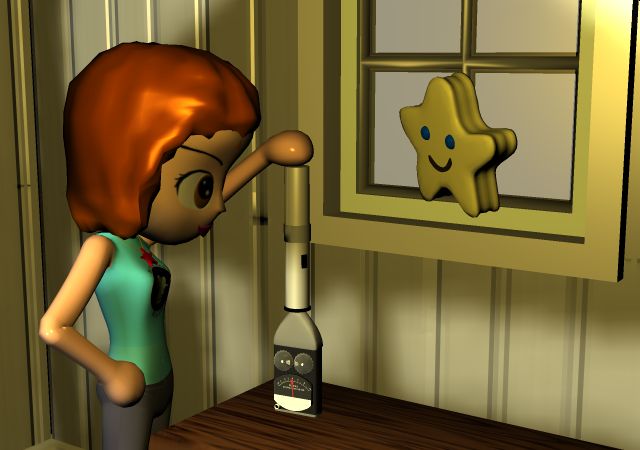 Here Polistra is using a Bruel & Kjaer pistonphone to calibrate her 1565A.
Here Polistra is using a Bruel & Kjaer pistonphone to calibrate her 1565A.
 The BK pistonphone produces an absolute 124 dB at standard barometric pressure, and comes with a barometer to calibrate the calibration more precisely.
The BK pistonphone produces an absolute 124 dB at standard barometric pressure, and comes with a barometer to calibrate the calibration more precisely.
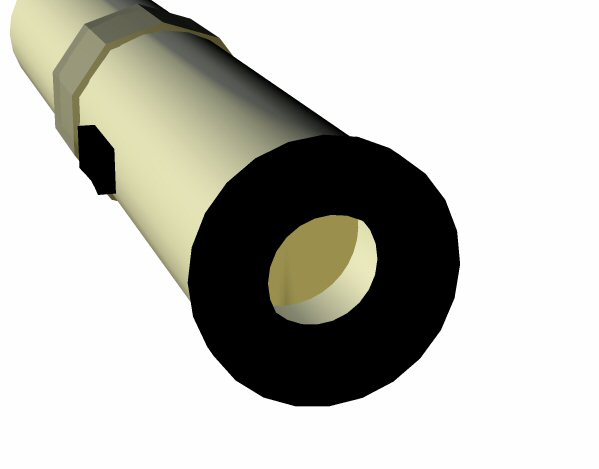 Here's the pistonphone as seen from the business end. The black plastic part fits over the standard microphone, forming a closed chamber between the pistons and the mic.
Here's the pistonphone as seen from the business end. The black plastic part fits over the standard microphone, forming a closed chamber between the pistons and the mic.
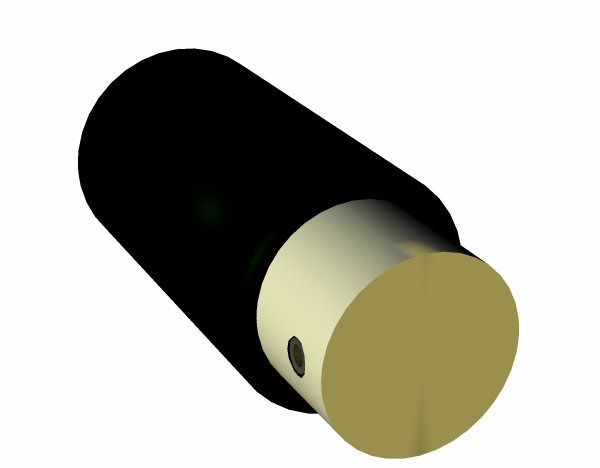 Here's the innards. When I worked in an acoustics lab at Penn State, I opened up a pistonphone to replace the batteries and saw this mysterious setup. I ass-u-me-d that the big silver thing was the piston, which seemed logical. It must push and pull directly in and out toward the mic.
Here's the innards. When I worked in an acoustics lab at Penn State, I opened up a pistonphone to replace the batteries and saw this mysterious setup. I ass-u-me-d that the big silver thing was the piston, which seemed logical. It must push and pull directly in and out toward the mic.
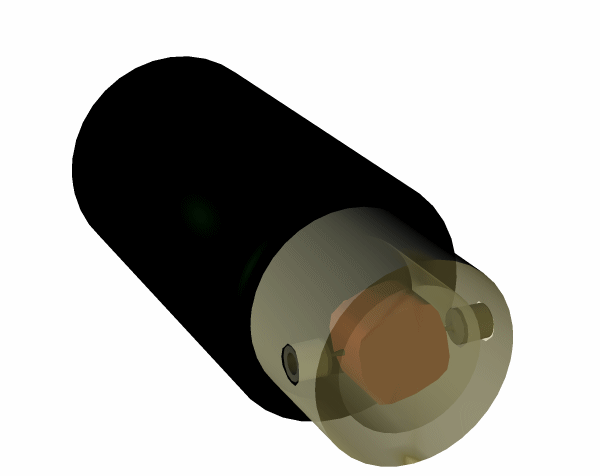 Logical but wrong. As I learned just now from the manual, the big silver thing is the 'engine block', and the little 'pins' in its sides are the actual pistons. The motor turns a cam, and the pistons ride in and out in a guaranteed sinusoid pattern with a guaranteed amplitude.
Logical but wrong. As I learned just now from the manual, the big silver thing is the 'engine block', and the little 'pins' in its sides are the actual pistons. The motor turns a cam, and the pistons ride in and out in a guaranteed sinusoid pattern with a guaranteed amplitude.
 The frequency wasn't guaranteed, but BK had a clever bit of analog design to regulate it almost precisely. There was a centrifugal pusher on the same shaft with the cam, and it would break the circuit to the base of the transistor when the piston frequency went above 250 cps. This didn't turn off the motor because current still flowed around the transistor through R1; but the reduced current allowed the motor to slow down to 250 cps.
Just as the design of the human sensory system can't be reduced to software, this type of elegant analog feedback loop can't be reduced to software.
= = = = =
** Shoot everyone full of penicillin at the first sign of cold: Neanderthal primitive analogy. As we know now, the CORRECT SCIENTIFIC MEDICAL approach is to shoot everyone full of fear and panic and isolation and depression and starvation and darkness and unemployment and screeching hopeless desperation, and then strangle them to death, in order to PREVENT people who were already dying from catching colds in the middle of dying. This is SCIENCE. Back in those primitive Neanderthal times, the primitive Neanderthal knuckle-draggers called our modern progressive methods "human sacrifice" because they were completely uneducated and stupid.
The frequency wasn't guaranteed, but BK had a clever bit of analog design to regulate it almost precisely. There was a centrifugal pusher on the same shaft with the cam, and it would break the circuit to the base of the transistor when the piston frequency went above 250 cps. This didn't turn off the motor because current still flowed around the transistor through R1; but the reduced current allowed the motor to slow down to 250 cps.
Just as the design of the human sensory system can't be reduced to software, this type of elegant analog feedback loop can't be reduced to software.
= = = = =
** Shoot everyone full of penicillin at the first sign of cold: Neanderthal primitive analogy. As we know now, the CORRECT SCIENTIFIC MEDICAL approach is to shoot everyone full of fear and panic and isolation and depression and starvation and darkness and unemployment and screeching hopeless desperation, and then strangle them to death, in order to PREVENT people who were already dying from catching colds in the middle of dying. This is SCIENCE. Back in those primitive Neanderthal times, the primitive Neanderthal knuckle-draggers called our modern progressive methods "human sacrifice" because they were completely uneducated and stupid.
 IETlabs continues to make and calibrate derivatives of GenRad products, and performs a tremendous service by maintaining old GenRad publications online. Maintaining old records of old technology is an even more important form of calibration in an era of Github memoryholing. Clearly they were using the original booklet from GenRad files, not one of the 20,000 printed copies that were ordered by the original form. Calibration at all levels! Thanks, IETlabs.
The book was aimed at industrial tech types who were suddenly required to deal with noise measurements by new OSHA regs in 1970. GenRad's simple sound level meter at that time (the 1565A) looked like this:
IETlabs continues to make and calibrate derivatives of GenRad products, and performs a tremendous service by maintaining old GenRad publications online. Maintaining old records of old technology is an even more important form of calibration in an era of Github memoryholing. Clearly they were using the original booklet from GenRad files, not one of the 20,000 printed copies that were ordered by the original form. Calibration at all levels! Thanks, IETlabs.
The book was aimed at industrial tech types who were suddenly required to deal with noise measurements by new OSHA regs in 1970. GenRad's simple sound level meter at that time (the 1565A) looked like this:
 The artist took full advantage of the meter's face, turning it into a character.
The artist took full advantage of the meter's face, turning it into a character.
 Decibels don't add like apples and oranges.
Decibels don't add like apples and oranges.
 Meters and humans don't work the same way. Human hearing is totally oriented toward filtering OUT stuff that doesn't matter, and bringing IN new information in the strict sense. If a sound is meaningful and new, we focus on it, starting with the remarkable tip-link mechanism in the cochlea, and continuing all the way into the higher language centers.
The meter has no idea which sounds are meaningful. It just picks up waves of air pressure and filters them by frequency.
Here's how the GenRad book balances out the human and meter perceptions:
Meters and humans don't work the same way. Human hearing is totally oriented toward filtering OUT stuff that doesn't matter, and bringing IN new information in the strict sense. If a sound is meaningful and new, we focus on it, starting with the remarkable tip-link mechanism in the cochlea, and continuing all the way into the higher language centers.
The meter has no idea which sounds are meaningful. It just picks up waves of air pressure and filters them by frequency.
Here's how the GenRad book balances out the human and meter perceptions:
You have been told, correctly, that measurement is the first step in the solution of a noise problem, and you have made your measurements. The noise, meanwhile, continues, apparently unintimidated by your bulging data book. But your day is near; you have the facts you need to act intelligently. An effective noise-reduction program requires careful planning. The man who finds a noise level too high and immediately says, "We'll just slap some acoustical tile here and there; that ought to take care of it," will probably be disappointed at the results. Not that acoustical tile isn't a good way to reduce noise - it often is. But this approach is like shooting a person full of penicillin at the first sign of a cold.** The more prudent course is to analyze the noise (either roughly with the sound-level meter, as discussed on page 74, or in detail with a sound analyzer), decide from this analysis what to do about it, and check results by further analysis. This procedure ensures that you're reducing the noise at the frequencies you're most concerned with - usually, those frequencies that are about the same as speech frequencies.The meter can filter by freq, so you have to use those filters as a crude approximation of our PURPOSE filters. The A-weighting filter is closest to the spectrum of speech, so the A is the best setting to measure interference with meaningful communication. The B weighting tends to focus on the upper freq range that is likely to cause damage to the cochlea. C is broadest, covering the whole range of hearing while ignoring freqs that don't affect the ears at all. The handbook ends with a poem!
With so much sound-measuring equipment and counsel available, there is no longer any need to suffer the annoyance and hazards of excessive noise. Ry acquiring a sound-level meter, you will take the first step on that golden stairway to the promised land where ... Like beacons on a sea of silence Life's silver sounds invade the air: The wind plays tunes upon the trees, The stream sighs and from the mountain flees, The rain's beat, the phoebe's call - Ears were made for sounds like these.The author isn't credited, and I can't find the text online, so it might have been written at GenRad. Do any modern industries have poets on staff, or use poetry in their handbooks? Especially poetry that says ears were MADE? Not even worth asking. = = = = = These unannoyable meters need to be calibrated in an unemotional way. GenRad's own calibrator was electronic, designed to produce the usual audiometer frequencies in the glottal range. (125, 250, 500, 1k, 2k). Because it was electronic, it wasn't an absolute or definitional calibrator. It wasn't controlled by a crystal or tuning fork, so its output depended on the quality and aging of the transistors and speaker.
 For absolute calibration, acoustics uses a pistonphone. The pistonphone is both absolute and definitional. It produces waves of air pressure with a permanent and unalterable amplitude, at a mostly consistent frequency.
For absolute calibration, acoustics uses a pistonphone. The pistonphone is both absolute and definitional. It produces waves of air pressure with a permanent and unalterable amplitude, at a mostly consistent frequency.
 Here Polistra is using a Bruel & Kjaer pistonphone to calibrate her 1565A.
Here Polistra is using a Bruel & Kjaer pistonphone to calibrate her 1565A.
 The BK pistonphone produces an absolute 124 dB at standard barometric pressure, and comes with a barometer to calibrate the calibration more precisely.
The BK pistonphone produces an absolute 124 dB at standard barometric pressure, and comes with a barometer to calibrate the calibration more precisely.
 Here's the pistonphone as seen from the business end. The black plastic part fits over the standard microphone, forming a closed chamber between the pistons and the mic.
Here's the pistonphone as seen from the business end. The black plastic part fits over the standard microphone, forming a closed chamber between the pistons and the mic.
 Here's the innards. When I worked in an acoustics lab at Penn State, I opened up a pistonphone to replace the batteries and saw this mysterious setup. I ass-u-me-d that the big silver thing was the piston, which seemed logical. It must push and pull directly in and out toward the mic.
Here's the innards. When I worked in an acoustics lab at Penn State, I opened up a pistonphone to replace the batteries and saw this mysterious setup. I ass-u-me-d that the big silver thing was the piston, which seemed logical. It must push and pull directly in and out toward the mic.
 Logical but wrong. As I learned just now from the manual, the big silver thing is the 'engine block', and the little 'pins' in its sides are the actual pistons. The motor turns a cam, and the pistons ride in and out in a guaranteed sinusoid pattern with a guaranteed amplitude.
Logical but wrong. As I learned just now from the manual, the big silver thing is the 'engine block', and the little 'pins' in its sides are the actual pistons. The motor turns a cam, and the pistons ride in and out in a guaranteed sinusoid pattern with a guaranteed amplitude.
 The frequency wasn't guaranteed, but BK had a clever bit of analog design to regulate it almost precisely. There was a centrifugal pusher on the same shaft with the cam, and it would break the circuit to the base of the transistor when the piston frequency went above 250 cps. This didn't turn off the motor because current still flowed around the transistor through R1; but the reduced current allowed the motor to slow down to 250 cps.
Just as the design of the human sensory system can't be reduced to software, this type of elegant analog feedback loop can't be reduced to software.
= = = = =
** Shoot everyone full of penicillin at the first sign of cold: Neanderthal primitive analogy. As we know now, the CORRECT SCIENTIFIC MEDICAL approach is to shoot everyone full of fear and panic and isolation and depression and starvation and darkness and unemployment and screeching hopeless desperation, and then strangle them to death, in order to PREVENT people who were already dying from catching colds in the middle of dying. This is SCIENCE. Back in those primitive Neanderthal times, the primitive Neanderthal knuckle-draggers called our modern progressive methods "human sacrifice" because they were completely uneducated and stupid.
The frequency wasn't guaranteed, but BK had a clever bit of analog design to regulate it almost precisely. There was a centrifugal pusher on the same shaft with the cam, and it would break the circuit to the base of the transistor when the piston frequency went above 250 cps. This didn't turn off the motor because current still flowed around the transistor through R1; but the reduced current allowed the motor to slow down to 250 cps.
Just as the design of the human sensory system can't be reduced to software, this type of elegant analog feedback loop can't be reduced to software.
= = = = =
** Shoot everyone full of penicillin at the first sign of cold: Neanderthal primitive analogy. As we know now, the CORRECT SCIENTIFIC MEDICAL approach is to shoot everyone full of fear and panic and isolation and depression and starvation and darkness and unemployment and screeching hopeless desperation, and then strangle them to death, in order to PREVENT people who were already dying from catching colds in the middle of dying. This is SCIENCE. Back in those primitive Neanderthal times, the primitive Neanderthal knuckle-draggers called our modern progressive methods "human sacrifice" because they were completely uneducated and stupid.Labels: Equipoise, metametrology, Metrology, storage
